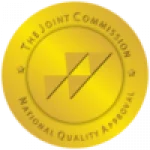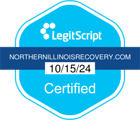Many individuals refrain from seeking assistance for alcohol use disorders due to their apprehension of experiencing uncomfortable withdrawal symptoms. Delirium tremens (DTs) is a potential consequence of heavy drinking cessation, posing a significant threat to one’s well-being. However, not everyone will encounter DTs, and the dangers of persisting in alcohol abuse are even more severe.
If you require support for alcoholism or any form of substance abuse, consider turning to Northern Illinois Recovery Center. Our alcohol addiction and mental health treatment programs provide clients with a full continuum of care. We incorporate cutting-edge evidence-based therapies and holistic approaches for the comprehensive and integrated treatment of alcohol addiction and delirium tremens. Do not allow an alcohol use disorder to continue disrupting your life. We can help you or a loved one.
What Is Delirium Tremens (DT)?
 Delirium tremens, commonly known as DTs, represents the most critical manifestation of alcohol withdrawal and can occasionally pose a life-threatening risk. This condition may arise when an individual with alcohol use disorder, particularly those with moderate to severe cases, abruptly ceases alcohol consumption.
Delirium tremens, commonly known as DTs, represents the most critical manifestation of alcohol withdrawal and can occasionally pose a life-threatening risk. This condition may arise when an individual with alcohol use disorder, particularly those with moderate to severe cases, abruptly ceases alcohol consumption.
While it is more prevalent in individuals with a history of chronic alcohol abuse, only a small percentage of those with alcohol dependence will develop DTs. Prolonged heavy drinking creates a dynamic imbalance within the body.
On one side, alcohol acts as a depressant, diminishing the activity of the central nervous system (CNS), which governs essential involuntary functions such as respiration and heart rate. Conversely, the CNS compensates by increasing its activity to maintain equilibrium. Over time, this heightened level of activity becomes the new baseline for the CNS.
When alcohol consumption is suddenly halted, it is akin to releasing the tension on the rope from the alcohol side. Consequently, the CNS no longer needs to counteract the depressant effects of alcohol to regulate its activity. However, the CNS cannot rapidly decrease its activity level, resulting in an overactive state that disrupts vital automatic bodily functions, ultimately leading to the onset of DTs.
How Common is DTs?
Alcohol use disorder is prevalent, with around 29% of adults in the United States expected to meet the criteria for it at some stage in their lives. Among those individuals, an estimated 1% to 1.5% will experience DTs.
Signs and Symptoms of Delirium Tremens
The diagnosis of delirium tremens is typically straightforward for medical or addiction treatment professionals due to its distinctive symptoms. This condition presents a diverse array of physical, mental, and behavioral symptoms. Among the most frequently observed symptoms of delirium tremens are:
- Severe confusion: It is possible to experience confusion and struggle to comprehend your environment or the circumstances you find yourself in. This is known as sensory disruptions and disorientation.
- Agitation and restlessness: You might display severe restlessness, irritability, and agitation.
- Hallucinations: Hallucinations involving sight, sound, and touch frequently occur in individuals experiencing DTs. These sensory distortions may cause significant distress and fear for those affected.
- Tremors: Delirium tremens frequently include intense tremors or shaking, impacting not only your hands but also various other areas of your body.
- Nervous system hyperactivity: One might encounter an accelerated heart rate (tachycardia), elevated blood pressure, profuse sweating, and a high body temperature.
- Seizures: Seizures may manifest in certain instances of delirium tremens.
- Fatigue: You might encounter significant exhaustion and a sense of weakness.
Numerous symptoms of DTs exist, with certain ones being more widely recognized than others. If left untreated, consequences could be severe. Alcohol use disorder and delirium tremens (DTs) can lead to various complications, many of which are severe.
How Long Does Delirium Tremens Last?

A common question asked is how long does delirium tremens last? DTs generally last up to seven days. Some people may experience some symptoms for up to two weeks. Upon cessation of extended and excessive alcohol consumption, individuals may encounter signs of alcohol withdrawal within a timeframe of 6 to 24 hours.
The onset of more severe symptoms, potentially leading to Delirium Tremens (DTs), typically begins between 12 to 48 hours following the last alcoholic beverage. Symptoms of delirium tremens persist for a duration of 3 to 4 days and usually subside after 5 days, although in some cases, they may persist for up to 10 days. DTs necessitate urgent medical intervention.
Causes and Risk Factors of Delirium Tremens
DTs are solely caused by withdrawal, which occurs when an individual with alcohol use disorder abruptly ceases alcohol consumption. Symptoms typically manifest within one to three days after the last drink and peak in intensity four to five days after the last drink. Various risk factors may increase the likelihood of developing delirium tremens (DTs). These factors include:
- An individual’s experience with symptoms of alcohol withdrawal, such as seizures and delirium tremens (DTs).
- Multiple occasions of ceasing heavy alcohol consumption.
- Frequent consumption of alcohol (the more alcohol consumed, the higher the risk).
- Co-occurring Disorders
- Age: The likelihood of experiencing DTs increases with age. Alcohol withdrawal and DTs are uncommon in individuals under 30 years old.
- Presence of other medical issues: These may include nutritional deficiencies or underlying conditions like heart disease and liver disease.
Delirium tremens is not something that can be cured, but it is highly manageable. Due to the confusion that is a prominent symptom of DTs, individuals with this condition may not be able to make well-informed decisions about their treatment. In such cases, it may become necessary for family members or close friends to step in and make decisions on their behalf.
One of the primary goals in managing this condition is to decrease the activity of the nervous system. Healthcare professionals will achieve this by administering medications that can reduce the activity of the central nervous system. Various types of medication can be effective in this regard.
Who Is at Risk for Delirium Tremens?
Delirium tremens do not typically occur following a brief period of alcohol consumption. The primary risk factors associated with this condition are past alcohol dependency and a prolonged period of excessive alcohol consumption, such as daily drinking over several months or years. Additional risk factors for the development of delirium tremens may include:
- History of previous alcohol withdrawal: If you have encountered symptoms of alcohol withdrawal in the past, you are more susceptible to experiencing DTs in subsequent withdrawal episodes.
- Advanced age: Elderly individuals are at a greater risk of developing DTs. Alcohol withdrawal tends to be more intense in older adults, and they may be more prone to the complications associated with DTs.
- Existing medical conditions: Individuals with pre-existing medical conditions may face an elevated risk of DTs. Liver damage or dysfunction can hinder the body’s ability to process alcohol and toxins.
- High tolerance to alcohol: Having a high tolerance for alcohol can increase the risk of DTs. Larger amounts of alcohol may be needed to achieve the desired effect.
- History of previous DTs: If you have previously experienced DTs during alcohol withdrawal, you are at a higher risk of experiencing DTs again.
The progression of delirium tremens (DTs) may not follow a predictable course. Not all individuals with these predisposing factors will necessarily develop the condition. If you possess these risk factors and start to exhibit signs of alcohol withdrawal, it is crucial to promptly seek medical assistance and monitoring to avoid or address DTs.
How is Delirium Tremens Diagnosed?
A healthcare professional, usually an emergency room doctor or another medical practitioner, can identify DTs through a variety of techniques and instruments. These may involve:
- Physical examination
- Neurological examination
- Specialized checklists with scoring tools that assess the likelihood of DTs based on symptoms. An example of this is the Clinical Institute for Withdrawal Assessment for Alcohol Revised Scale (CIWA-Ar).
- Laboratory testing
Delirium tremens can be life-threatening. In some cases, it can lead to death if not treated right away. The majority of diagnostic tests for DTs are conducted in a laboratory setting and typically require blood or urine samples. Additional tests may be considered based on your specific symptoms or existing health conditions. Your healthcare provider will be able to provide more information regarding the recommended tests and their significance for you or your family member.
Treatment for Delirium Tremens

The management of delirium tremens typically requires hospitalization. Treatment protocols include the administration of medications aimed at alleviating the symptoms associated with DTs and mitigating potential complications. The initial step in managing DTs typically involves the administration of sedatives.
These medications are effective in reducing central nervous system activity, which is primarily responsible for the severe complications associated with DTs. Benzodiazepines are frequently utilized to depress the central nervous system, which aids in diminishing agitation, regulating tremors, and preventing seizures.
It is important to note that the medications prescribed for DTs pose a risk of abuse; therefore, all prescriptions must be issued by a qualified medical professional. Additionally, intravenous fluids and electrolyte replenishment may be essential to rectify dehydration and imbalances resulting from alcohol withdrawal.
The primary cause of DTs is alcohol use disorder. The ultimate objective of post-DT treatment is addressing alcohol use disorder. Various treatment methods exist for alcohol use disorder. Seeking treatment can significantly lower the risk of experiencing DTs again in the future. The best way to avoid or reduce your risk of developing alcohol use disorder (and DTs) is to drink in moderation or stop drinking alcohol altogether.
Despite receiving medical intervention, death remains a potential complication of DTs. If left untreated, approximately 15% of individuals with DTs will not make it. The likelihood of mortality increases for those with underlying severe health issues.
With proper treatment, the survival rate for DTs is around 95%. Seeking treatment promptly enhances the chances of survival and a favorable prognosis. NIRC offers the following treatment programs
Medical detox is the initial phase in the process of allowing your brain and body to recover. Under the supervision of medical professionals, you will cease drinking. These healthcare providers will offer you medical assistance and attention during the withdrawal period.
In a residential drug rehabilitation program, you reside in a treatment facility with continuous care from experts. Individual, group, and family therapy sessions will aid you in understanding how to remain sober and sustain your progress.
A partial hospitalization program serves as an outpatient addiction treatment option. This means you do not reside in a treatment center. You will learn to manage your treatment schedule while maintaining your independence. It represents another step towards departing our facility after attaining sobriety.
An intensive outpatient program delivers therapy and assistance at a treatment center. You reside at home or in a sober living environment. IOPs are briefer than inpatient programs and concentrate on reintegrating you into society while developing skills to prevent relapse.
Outpatient addiction treatment is a secure yet less intensive recovery choice. It enables you to undergo alcohol treatment while fulfilling regular obligations to family, work, or school.
Addiction counseling plays a crucial role in the treatment of alcoholism. Various approaches are commonly utilized including
Coginitive-behavioral therapy focuses on identifying and modifying negative thought patterns and behaviors.
Dialectical behavior therapy is another type of therapy that emphasizes emotional regulation, distress tolerance, interpersonal skills, and mindfulness.
Family therapy involves the participation of family members to address communication, boundaries, and support issues that are affected by addiction and mental illness.
Trauma therapy is essential in treating alcohol abuse by addressing underlying trauma that may lead individuals to turn to alcohol as a coping mechanism. This therapy helps individuals process and heal from traumatic experiences, enabling them to manage without relying on alcohol.
Healing and Recovery is Available at NIRC
Northern Illinois Recovery Center, located in Crystal Lake, IL, provides a comprehensive range of services for individuals struggling with alcohol addiction. Engaging with our licensed treatment professionals is significantly more effective than attempting to quit drinking independently. Our addiction specialists are equipped to address co-occurring disorders, enabling you to regain a fulfilling quality of life.
Hope for recovery is within reach. Reach out to our admissions team today for insurance verification or to inquire about our alcohol rehabilitation programs. Our team is available to verify your insurance coverage or discuss alternative payment options. Contact us today to begin your journey towards recovery.




